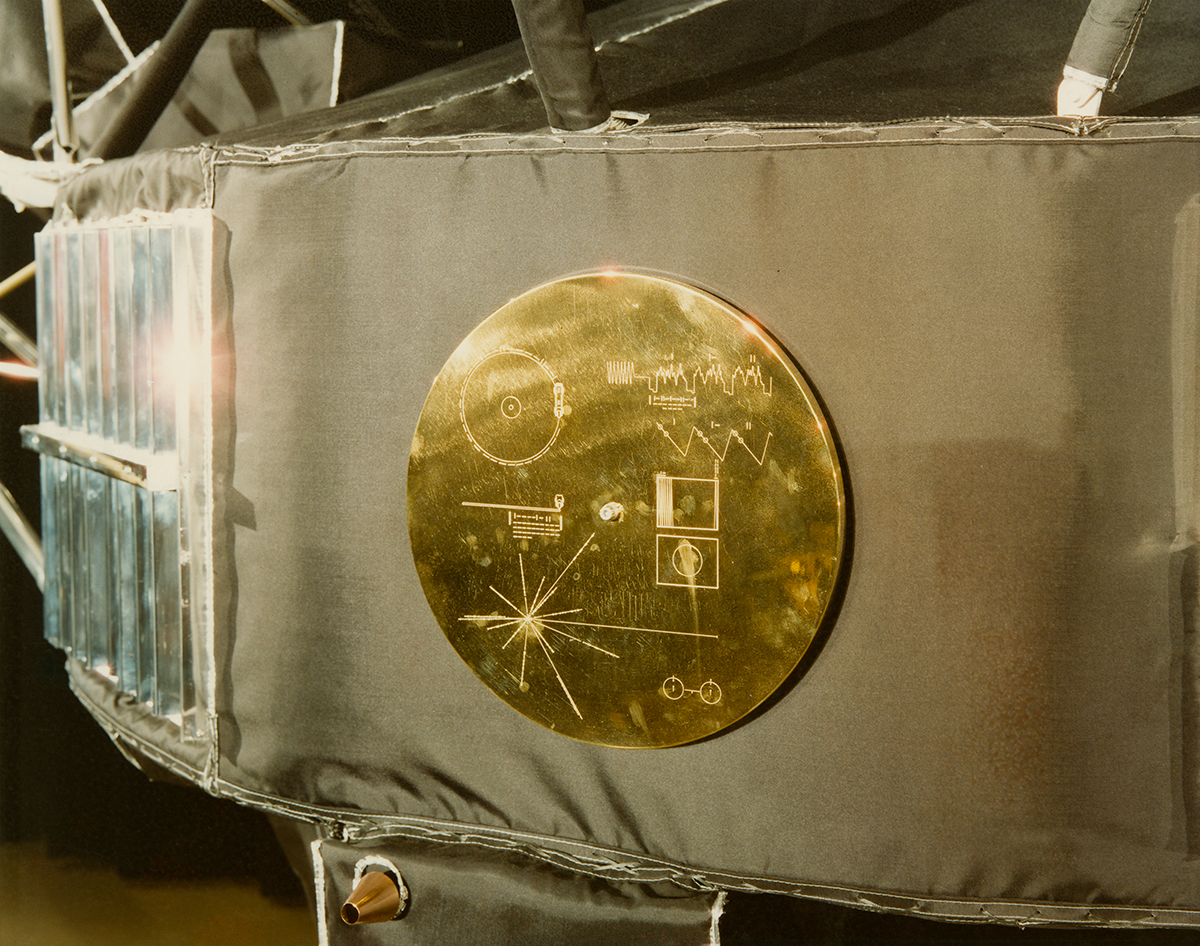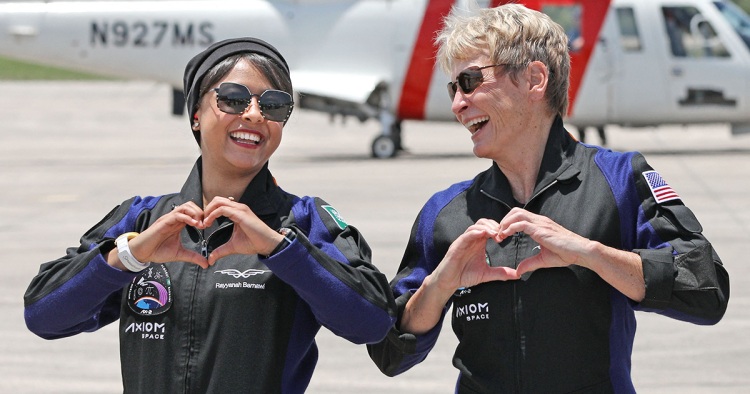“Tahiat li’asdiqayina fil alnujumi. Wanatamanaa ’an naltaqi bikum yawman ma.”
“Greetings to our friends in the stars. We wish that we will meet you someday.”
This was the Arabic declaration I recorded, which NASA sent into the cosmos 47 years ago on the Voyager Golden Records, a collection of images, music, and language affixed to the twin probes of the same name, showcasing the diversity and triumph of life on Earth. My contribution, hopeful and welcoming, entertained the tantalizing possibility that the Voyager probes and their Golden Records could be intercepted by another intelligent civilization at some point in their interstellar journey.

circa 1977. Photo by Space Frontiers/Archive Photos/Getty Images.
Today, Voyagers 1 and 2 are 15 billion miles from their earthly origin, but the recorded expressions of hope they carry seem utterly misplaced against the daily images of devastation and heartbreak that dominate headlines from the region my greeting was intended to represent. From Israel-Gaza to Sudan and Yemen to Syria, war, looming famines, leveled hospitals, and missing hostages, stand in stark contrast to the images and spirit of optimism, comradery, and global communion etched into the twin gleaming disks speeding away from the center of our Solar System at more than 35,000 kilometers per second.
At a time of such ruinous conflict, how can we course-correct and create a future that reflects the values that informed the Golden Records’ creation? The answer, I believe, can be found in the history, and future, of space exploration itself.
Modern space exploration has regularly benefited from sustained international collaboration, even amidst some of the most trying of global circumstances. In 1975, at the height of tensions between the United States and the former Soviet Union, the two would-be rivals conducted their first jointly crewed space mission. Later, the US and Russia expanded their international collaboration in outer space to establish the International Space Station (ISS), alongside additional partners from Europe and Japan.
Even through relations between Russia and the US are today going through one of the sharpest downturns in their history, the two countries continue to find ways to collaborate in space. In December, NASA and Russia’s Roscosmos announced that joint shuttles to the ISS would continue through at least 2025. Last month, astronauts from Russia, Belarus, and the United States launched aboard a Soyuz rocket to the station.
Outer space’s suitability as a platform for international cooperation will only strengthen as new, previously excluded nations, governments, and voices are empowered to contribute to the field. Fortunately, many of these new actors are emerging in the Middle East itself. In 2020, the United Arab Emirates launched the indigenously developed Hope Probe, which successfully entered orbit around Mars to study the planet’s atmosphere in February 2021, the first for an Arab country. Emirati astronauts have also taken part in missions to the ISS. Most recently this included now-UAE Minister of State for Youth Affairs Sultan al-Neyadi, who, in September 2023, returned to Earth after a six-month stint, during which he became the first Arab astronaut to conduct a spacewalk.
They are not alone. From the Middle East region, Saudi Arabia, the UAE, Bahrain, and Israel are among the 36 signatories of the Artemis Accord, a US-led multinational agreement that expresses a commitment to the civil use of outer space, alongside additional components related to international cooperation, research exchange, and interoperability. Within NASA’s Artemis program, the UAE has pledged to develop and provide an airlock for Gateway, a space station that will orbit the moon.
Almost five decades after my greeting became the first Arab woman’s voice in the stars, Arab women have now physically been in space. In May 2023, Saudi astronaut and biomedical researcher Rayyanah Barnawi broke the atmospheric glass ceiling by conducting stem cell and cancer research experiments aboard the ISS — work that may one day benefit us all. This past March, Emirati astronaut Norah al-Matroohsi became the first Emirati and Arab woman to graduate from NASA’s astronaut training program. I am thrilled that this week the Middle East Institute will honor the accomplishment of Ms. Barnawi and the path she has created for all Arab women as they present her with their “Visionary Award.” I hope more follow in her and Ms. Matrooshi’s footsteps.
The roots of the most pressing conflicts in today’s Middle East will undoubtedly require complex negotiations and painful compromises to reach lasting solutions. Space research alone will not fix them. What the history of space exploration does show us is that international collaboration can continue, and even thrive, at times of intense global tension. In outer space, rivals and friends alike continue to work together to explore the stars, advance technological and biomedical breakthroughs, and cure disease, even as division perpetuates conflict on the Earth below. The opening up of this sector to once overlooked voices, such as Arab women, only increases its potency as a model for international cooperation across differences. And for this reason, my hope only grows.
Amahl Shakhashiri Drake is a Lebanese-American who, while working at Cornell University in the prelude to the launch of the Voyager probes in 1977, was recruited by Carl Sagan to contribute an Arabic greeting to the Voyager Golden Record, a phonographic account of humanity accompanying the Voyager probes. Her voice was the first recording of an Arab woman in outer space. She is the wife of the late famed astrophysicist Frank Drake, developer of the namesake Drake Equation and founding figure in the search for extraterrestrial life.
Photo by GREGG NEWTON/AFP via Getty Images
The Middle East Institute (MEI) is an independent, non-partisan, non-for-profit, educational organization. It does not engage in advocacy and its scholars’ opinions are their own. MEI welcomes financial donations, but retains sole editorial control over its work and its publications reflect only the authors’ views. For a listing of MEI donors, please click here.













